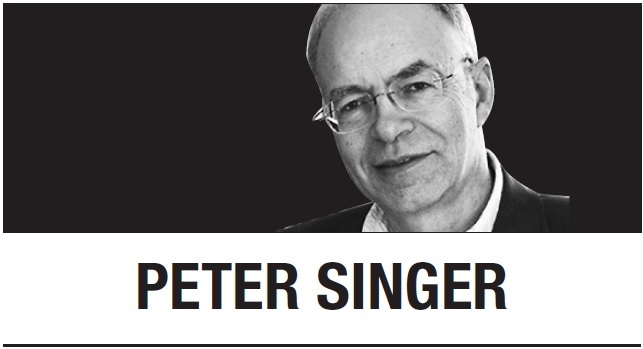Like many other democracies, Australia has experienced growing political polarization in recent years, particularly during the last nine years of the conservative government, led by the Liberal Party, in coalition with the smaller, rural-based National Party. That is why the result of the federal election in May could hold important lessons for other polarized polities.
Consider the outcome in Kooyong, the safest of all Liberal seats. The electorate covers some of Melbourne’s most affluent suburbs and, since its creation in 1901, has always elected a Liberal or a representative of its conservative predecessors. In the recent election, the sitting member for Kooyong, Josh Frydenberg, served as federal treasurer and deputy leader of the Liberal Party and was widely talked about as a future prime minister.
No one gave the main opposition Australian Labor Party any chance of winning Kooyong -- and they were right about that. But Frydenberg also faced a more unusual opponent this year: Monique Ryan, a pediatric neurologist who ran the neurology department of Melbourne’s leading children’s hospital. Ryan stepped away from that role to campaign as an independent candidate in the electorate where she lived because she was bitterly disappointed with the Liberal government’s failure to tackle climate change. She also campaigned for an independent body to investigate corruption in politics, and for equality and respect for women.
Australia’s lower house consists of single-member electorates, with members elected by preferential voting, also known as ranked-choice voting, or instant run-off, which is not to be confused with proportional representation. After the distribution of preferences was tallied, Ryan defeated Frydenberg, 53 percent-47 percent.
Ryan was one of a group of candidates in the election known as the “teal independents” because their economic policies tend to be conservative (blue is the color of the conservative parties in Australia), but their climate policies are green. That combination was well-suited for the conservative electorates in which they stood.
Similarly, in three Sydney electorates that were almost as safely conservative as Kooyong, the incumbent Liberals were defeated by local professional women campaigning for stronger action on climate change. The same thing happened in Perth, and in another Liberal stronghold in Melbourne. Altogether, six new teal independents, all women, and all focused on climate change, were elected to the House of Representatives. With three independents who were re-elected to seats they had held previously, and another new independent who is not aligned with the teal group, the Australian parliament will have ten independents.
The Australian Greens, which prior to the election had never held more than a single seat in the lower house, will have four in the new parliament. In a lower house of 151 members, 14 for whom climate change is an issue of supreme importance will be unaligned with the major parties.
Several factors made this remarkable result possible. The independents who campaigned on the need for stronger action on climate change were supported by Climate 200, a fundraising body that distributed 12 million Australian dollars ($8.7 million) to 23 climate-focused independents. Its practical campaign advice was also important for candidates who had never run for office. Each independent ran in their own community, supported by local volunteers who knocked on a lot of doors.
Preferential voting was essential to the victories of the teal independents, because it meant that they could win without receiving the most first preference votes. The six new teal independents who won did so by finishing ahead of the Labor candidate in the electorate they were contesting and keeping the Liberal candidate below 50 percent of the vote. The candidates with fewer votes were then progressively eliminated, starting with the candidates who received fewest votes, and the preferences of voters for these candidates were distributed. Predictably, both the Greens and Labor recommended that their voters give their preferences to the independents ahead of the Liberals. Those preferences were then enough to put the independent candidate ahead of the Liberal.
Labor won a narrow majority of two seats in the lower house, so, strictly speaking, it will not need the support of the Greens and independents there. But Labor will need support from the Greens and at least one independent in the Senate. The new prime minister, Anthony Albanese, will almost certainly receive it, having signaled a shift in climate policy by saying that he wants to make Australia “a renewable energy superpower.”
In countries in which politics is becoming increasingly polarized, the Australian election should increase support for voting reform. Outside Australia, preferential voting is used nationally in Ireland, Malta, Nauru, and Slovenia. In the United States, it is used in Alaska and Maine, and in many cities, including New York, and there is support for introducing it in several other jurisdictions.
Extremism flourishes in voting systems in which the candidate with the most votes wins, even if the winner has the support of a minority of voters. None of the six new teal independents received the most first preference votes in their constituency; but in each case, a majority of voters preferred them to the Liberal candidates who did receive the most first preferences. Allowing voters to express their second or third preferences helps moderates defeat extremists.
The Australian election should also help to dispel the cynicism that leads many to think that politics never changes anything. If community-based independents could make a dent in the major party duopoly in Australia, then, with the right voting system, they can do so elsewhere as well.
Peter SingerPeter Singer, a professor of Bioethics at Princeton University, is the founder of the charity The Life You Can Save. -- Ed.
(Project Syndicate)






